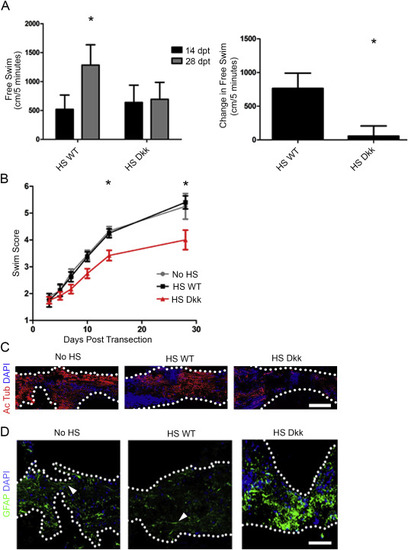- Title
-
Wnt/β-catenin signaling promotes regeneration after adult zebrafish Spinal Cord injury
- Authors
- Strand, N.S., Hoi, K.K., Phan, T.M., Ray, C.A., Berndt, J.D., Moon, R.T.
- Source
- Full text @ Biochem. Biophys. Res. Commun.
|
Wnt/β-catenin signaling is increased after spinal cord injury. (A) Representative images of Tg(7xTCFxla.siam:mCherryNLS) fish after sham surgery or spinal cord transection that were used for quantification of mCherry + cells. Graph shows the quantification of mCherry + nuclei at the indicated times. Green asterisk marks central canal. (B) Graph of the relative abundance of wnt4b transcripts as measured by using quantitative PCR from samples of spinal cords collected at the indicated times after spinal cord injury. (C) Representative images of Siam:mCherry x Hsp70l:Dkk double transgenic fish at 3 dpt. Graph shows the quantification of mCherry + nuclei times at indicated times and genotypes. Green asterisk marks central canal. *p < 0.05; scale bar, (A, C) 100 µm; n ≥ 5 for (A), n = 3 for pooled samples in (B), n ≥ 3 for (C). Graphs (A, C) show mean ± SEM, graph (B) shows mean ± St Dev. (For interpretation of the references to colour in this figure legend, the reader is referred to the web version of this article.) |
|
Wnt/β-catenin signaling is necessary for locomotor recovery after spinal cord injury. (A) Free swimming behavior HS WT and HS Dkk fish at 14 and 28 dpt, including mean change in distance swum between 14 and 28 dpt. (B) Swim score analysis of No HS, HS WT, and HS Dkk fish through 28 dpt. (C) Acetylated tubulin staining in No HS, HS WT, and HS Dkk fish at 21 dpt. (D) GFAP staining in No HS, HS WT, and HS Dkk fish at 14 dpt. White arrowheads indicate glia with bipolar morphology. *p < 0.05; scale bar, (C, D) 100 µm; n e 5 for (A, B, D), n ≥ 3 for (C). Graphs show mean ± SEM. PHENOTYPE:
|


